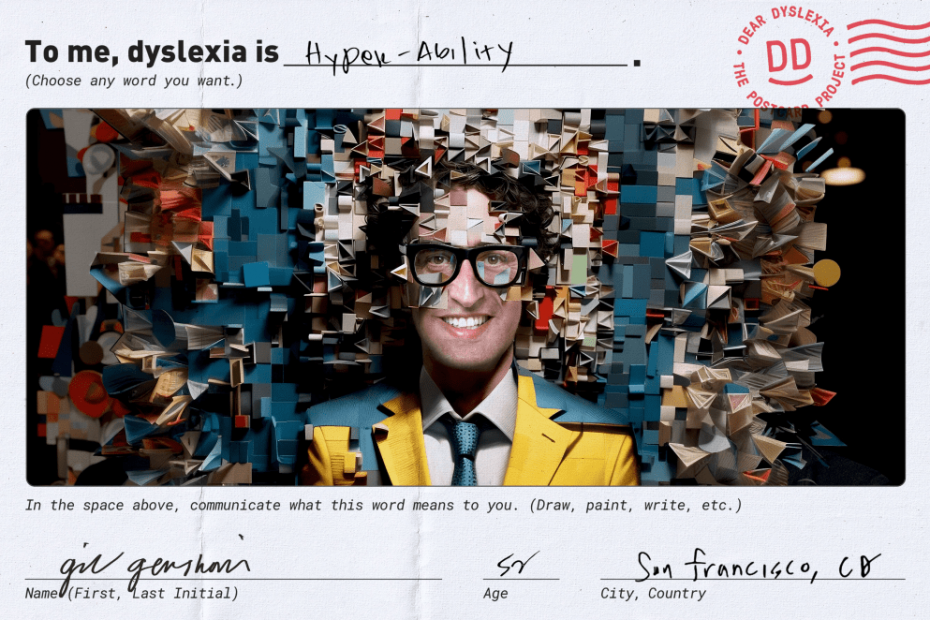This guest op-ed is by Gil Gershoni is the co-founder and creative director of Gershoni Creative and the founder of Dyslexic Design Thinking.
I am a creative director with dyslexia.
In the past, seemingly mundane tasks like sending an email presented a challenge, draining time and mental energy. I would often spend upwards of an hour dictating, reading, re-reading, and asking a colleague to proofread before finally hitting send. Now, with a simple prompt in ChatGPT, my thoughts are magically transformed into clear, concise words. What once took precious time can be accomplished with a click, freeing up my brain to focus on what it does best: bringing ideas and strategies to life that help my clients stay ahead of the curve.
This is just one example of AI leveling the playing field, enabling nonlinear thinkers like me to communicate as effectively and efficiently as possible.
Yet, for design and creative firms and professionals, AI presents an even more profound opportunity: the cognitive abilities inherent in dyslexia, like the knack for brainstorming endlessly, tackling problems from various perspectives, and manipulating objects in the mind’s eye, uniquely equip us to stretch the boundaries of generative design tools such as Midjourney, DALL-E, and DeepArt.
This is a game-changer. AI not only eliminates the logistical and communication barriers that have sometimes hindered the success of neurodiverse individuals in the workplace but also empowers people with dyslexia to leverage their inherent strengths and supercharge their creativity.
Case in point: You can present me—and most dyslexics I know—with nearly any business challenge, and we can riff on it and problem-solve for hours. We leverage each other’s ideas as springboards, challenge thoughts, and flesh solutions out collaboratively. Our capacity to dissect problems from multiple angles, akin to turning a simple problem over as if it were a tesseract, distinguishes us.
This same way of thinking lets me really push the limits of AI design tools. I thrive on playing around with art directions, constantly tweaking and refining them to bring ideas to life. For dyslexics, whose minds are often in overdrive, it’s like always having a tireless collaborator by your side, especially when working against tight deadlines. AI steps in when my dyslexic brain might be racing, helping me translate mental images into designs more quickly. By guiding the AI—use this relief, try this mode—I can accelerate the creative process and ensure concepts materialize closer to how my mind envisioned them.
And isn’t that just what every agency is after? In a world where ChatGPT can dish out answers faster than you can say “Google it,” intelligence means much more than just knowing stuff. In our industry, successful strategies and campaigns are ultimately about imagination – something AI will never be able to master. AI doesn’t stand for Artificial Imagination because that comes from the human brain, which is irreplicable. And you can’t teach an AI to think like a dyslexic even if you tried. The magic of dyslexic thinking lies in its ability to break free from the norm and see things in a totally fresh light.
A great strategy or campaign is all about asking the right questions to solve problems and challenges. You have to know what you need to achieve and then dig deep. Those who use AI in simplistic and basic ways risk regurgitating outdated ideas and strategies. After all, AI is programmed to be predictable and reliable. But the magic of human creativity lies in the ways that the brain thinks unpredictably – the instances when it fails to give the same old tired answer to the same old tired question. And that’s what dyslexics are really good at.
So what should agencies do to capitalize on this moment?
First and foremost, companies must fully embrace neurodiversity as a valuable asset in the workplace rather than viewing it as a limitation. Sir Richard Branson and the nonprofit Made by Dyslexia have championed this idea by collaborating with LinkedIn to enable people with dyslexia to showcase “Dyslexic Thinking” as a skill on their profiles. Branson himself has added this skill to his LinkedIn profile, and I have done the same. However, a 2020 report from U.K. employers revealed that 50% of HR managers admitted they would not consider hiring neurodivergent candidates. If you look at the top of every field, there is a dyslexic who threw out the rule book. Think: Steven Spielberg, Barbara Corcoran, and Ikea founder Ingvar Kamprad. Businesses that fail to recognize this opportunity risk losing valuable talent to more forward-thinking companies.
Companies should also ensure that neurodiverse employees can access essential tools such as ChatGPT, Grammarly, Co.Writer, and VoiceDreamReader that help them communicate and work efficiently.
Lastly, they should offer thorough training on all AI tools, and consider forming specialized teams of neurodivergent employees dedicated to experimentation and innovation. These teams can craft instructions, best practices, and workflows to unleash the full creative power of AI tools.
When I was ten, I became a professional magician, which became my creative refuge — a sanctuary away from the confines of the classroom where, as a dyslexic, I often felt out of place. It’s one of the reasons I like to say there is a little bit of magic in dyslexia. Now, with the rise of generative AI, I’m more convinced of this than ever. When AI is harnessed to its fullest extent and paired with the unique strengths of dyslexics — strong problem-solving skills, unconventional thinking, and a knack for tackling challenges from many perspectives — the potential for magic and unbridled creativity becomes boundless.
Images created by the author.
